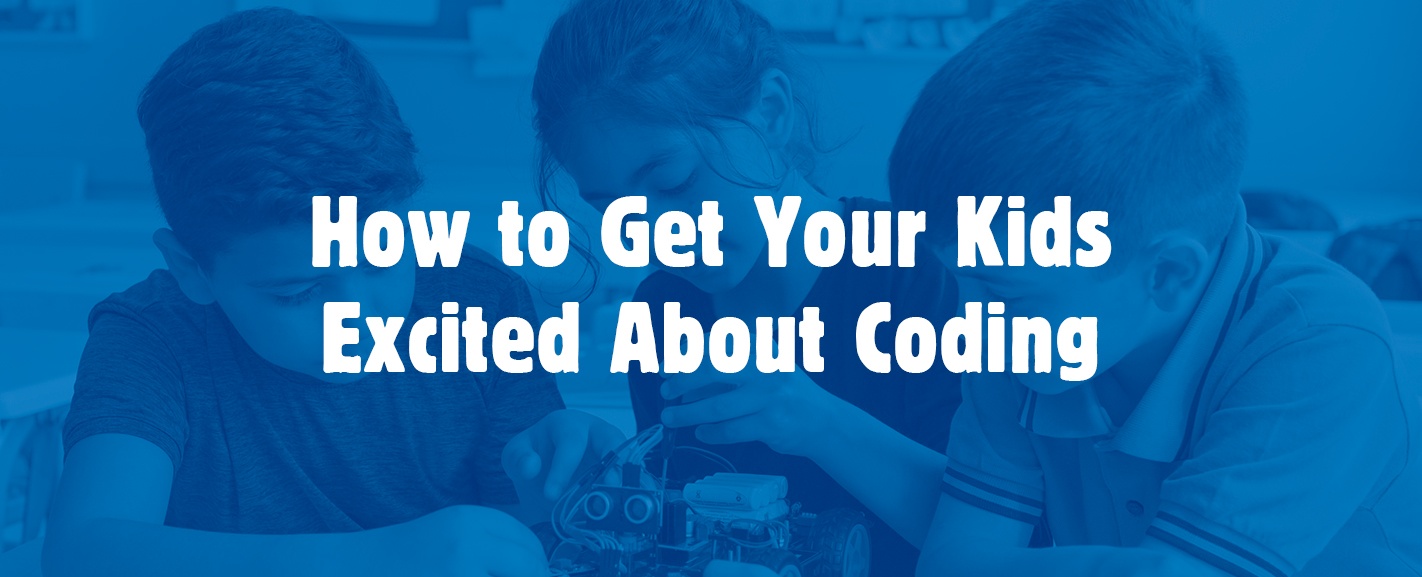
Programming isn’t only for grown-ups — kids of many ages can learn this skill, which will help set them up for a successful future and give them the skills they need to engage with the world around them. If you aren’t familiar with the best coding programs for kids or where to begin, we have some tips to get you started.
In this guide, we’ll discuss how to get your kids excited about coding with our help. You’ll soon understand how to teach your kid about programming and why every child should learn to code for the skills and benefits it provides.
What Is Coding and Why Is It Valuable?
Code creates instructions that tell your computer what to do. Without it, computers would be unable to function. Code is needed to run any variety of functions on our computers, from searching a simple question to buying something online. Using hundreds and hundreds of coding languages, programmers create a vast array of fun and useful applications.
While the concept of coding may sound complicated, there are simple learning tools you can use that feature fun ways to teach kids to code. They develop the foundations for code and improve other skills along the way. But why should kids learn to code?
Code is its own language. You’ve probably heard the benefits of teaching children a new language at a young age. When kids can grasp and memorize the language, they are setting up a future where they can become fluent. Teaching kids coding at a young age can develop the same ability. But there are so many other benefits of coding for kids and students. Some of those include:
- Understanding the world: From smartphones to smart homes, technology is all around us. One of the benefits of teaching kids to code is developing an understanding of the world. Kids will see real-world examples of the coding they learn and see its importance in our daily lives. Whether that technology is life-saving or provides entertainment, it has become vital in our lives, and children can understand that better once they learn to code.
- Competitive advantages: Before your kids enter the workforce, they’ll likely further their education. A background in programming before secondary education gives your kids an impressive edge. They may have an easier time getting into coding and other advanced programs in college. If your child is in coding programs, you can include the skills learned from coding on resumes and college applications.
- Job prospects: In 2015, there were over eight and a half million jobs in the STEM field. Of those, almost half were computer-based. Among that category were jobs such as software developers and computer programmers, both of which rely on some form of coding. These job prospects will only grow in the future as we rely more and more on technology in our daily lives. Teaching coding to kids can help set them up for a future of job opportunities and security. Many of these careers also pay well, considering it’s such a specialized skill to understand.
Due to the benefits of coding for students, many schools offer programming classes in high school and even earlier. Getting a head start can set your child up for success in school and life beyond graduation. Along with those valuable qualities of coding, there are even more benefits that the skill provides, especially for children.
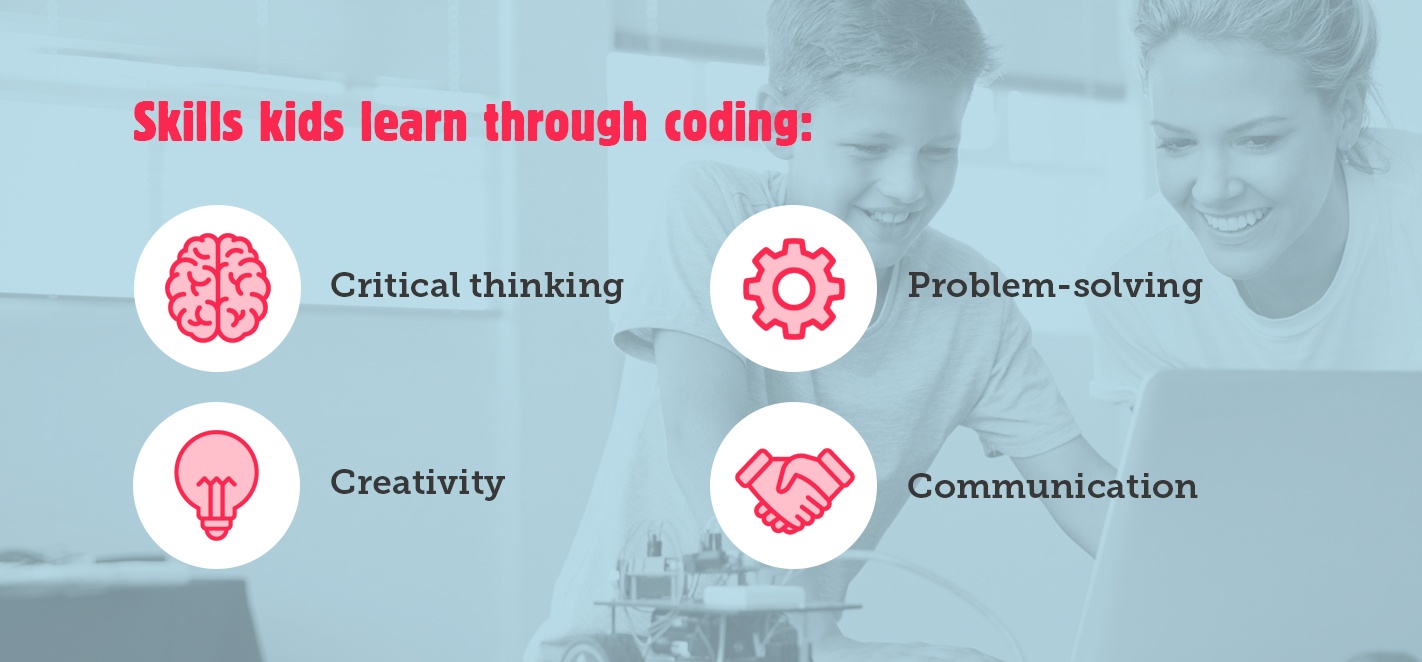
Why Kids Should Learn to Code
So, why teach your kid to code? Learning about programming can teach your kids essential skills that apply to coding and life. The following are skills kids learn through coding:
- Critical thinking: Engaging in coding allows children to think critically about programming and the world around them. As they code, programmers think about a situation from all angles to assess the best course of action. Coding teaches your kids this skill to use for programming activities and in their daily lives.
- Problem-solving: Problem-solving is like critical thinking — it focuses on a particular situation or task. A child learning coding will have to problem-solve when they create code to fulfill a certain task and as they debug that code for errors. Coding becomes a puzzle of language that programmers must solve, which will develop into a skill for everyday life.
- Creativity: The possibilities are endless when it comes to coding. Code creates apps, websites and more, and once kids have this skill, they can unleash their creativity into code. They’ll have an outlet to express themselves that doesn’t necessarily require any visual art skill.
- Communication: Coding is a language, but not in the traditional sense. When someone writes code, they transform a complex outcome into smaller steps or components that they translate into code for a computer to understand. That concept extends into daily life as children communicate complex thoughts and concepts in a way others can easily understand.
These and other skills learned from coding will help in school and future careers. Of all the skills coding improves in children, critical thinking and teamwork were rated as “very important” to employers and success, according to a study that evaluated applied skills in the workforce. Even if your children don’t pursue further education or a career in programming, the skill is still invaluable, thanks to the other traits it provides.
What Is Best for Kids to Learn?
Advanced coding concepts and languages won’t welcome your child into the programming world, as well as other activities will. You want things that are hands-on or explain coding in a simple way that kids can understand.
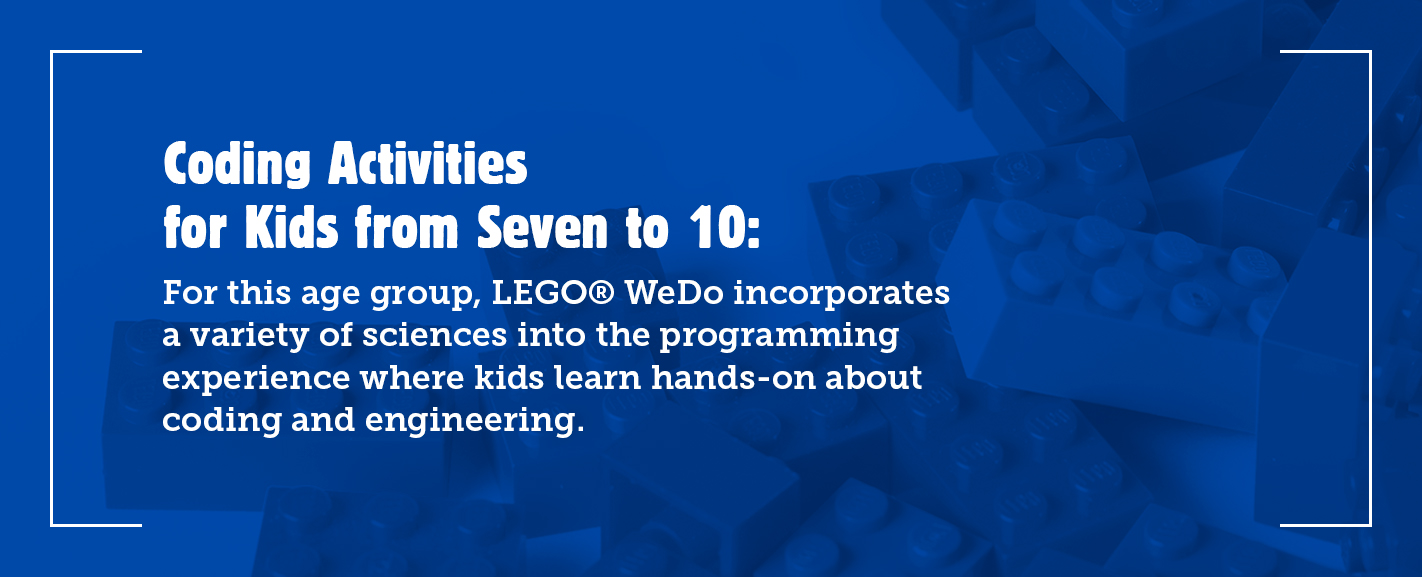
Coding Activities for Kids
To get kids excited about coding, you need to make the activity accessible for them. Too difficult, and kids may become too frustrated to continue learning. Too simple or un-engaging, and kids won’t be interested in the first place.
One way to pick the right coding activity for your kid is to choose based on their age range. Activities by age will have the right level of engagement and complexity that will help keep your child interested in learning. Find coding activities for kids from ages:
- Three to five: Engage younger children with games that include programming lessons. Fun activities like the board game Robot Turtles or the activity book “Hello Ruby: Adventures in Coding” teach the fundamentals while letting kids have fun. They begin an interest in coding that could stick with kids as they get older.
- Five to seven: As children who learn coding get older, they can begin to explore activities that focus more on coding and less on play. ScratchJr allows this age group to design stories and games while learning about problem-solving and creativity.
- Seven to 10: For this age group, you want coding activities that are anywhere from easy to intermediate, depending on your child’s previous coding experience. Swift Playgrounds, an app, is colorful and approachable for young kids but can also be used to write real code to learn fundamentals. LEGO® WeDo incorporates a variety of sciences into the programming experience where kids learn hands-on about coding and engineering.
- 10 to 13: Older kids can participate in hands-on coding experiences that are more advanced. Scratch, developed by MIT, is free to download software that lets kids drag and drop pieces of code to create anything from animated scenes to games. LEGO® Mindstorms combines coding with a physical experience as kids take a hands-on approach to designing, building and programming a creation.
If you know about coding yourself, you can always try to create a game with your kids in mind, but these games and activities are intuitive for children and parents who have no coding experience. Feel free to use coding games for younger ages with older children who don’t have experience with coding or learn at a slower pace. If you have kids across various age groups, play a coding game meant for the youngest kid with everyone involved.
What Programming Languages Are Good for Kids?
With so many programming languages out there, you’re likely not sure which are good for kids. The language should be easy enough for kids to grasp and focus on developing the skill without feeling overwhelmed. At the same time, you want older kids to have some sort of challenge that keeps them interested in learning and sets up a foundation for advanced programming concepts in the future.
Luckily, because there are so many programming languages, there are ones that are simple enough for kids to learn. The language itself is not necessarily important. You just want something that introduces basic concepts and develops a fundamental understanding of coding. Some programming languages for kids include:
- Blockly
- Python
- Lua
- Unity
Those languages combine coding with visual results in different platforms, from games to animated stories. It’s also common to use these programming languages to teach kids to code:
- Binary: This language is the basis of data in computer systems, and because it consists of only ones and zeroes, it’s a great way to introduce young kids to the world of computer language, developing an understanding of patterns for young children.
- HTML and CSS: These coding languages are a great place to start to learn some fundamentals about writing code. The results are more visual, creating basic webpages, but older kids may enjoy the process.
- Alice: While Alice is a bit more complex than Scratch, the fact that it is object-oriented makes it more accessible for kids. The three-dimensional, visual results allow kids to engage in storytelling and game creation that make coding more engaging.
- Java: Older kids and confident coders can dive into Java, a widely-used language, that is more complex. If your child is older and has more patience to learn coding, Java is a great gateway into even more complex languages.
These and other coding languages can help introduce kids to the fundamentals of coding and prepare them to learn more complex language in the future. Choose a coding language for your child to learn based on:
- Your child’s age
- Their interests
- What they want to learn with coding
- What they find easiest and engaging
Selecting a language based on what will be more interesting to your kid is one great way to start teaching them about coding, but there are even more ways to introduce the skill.
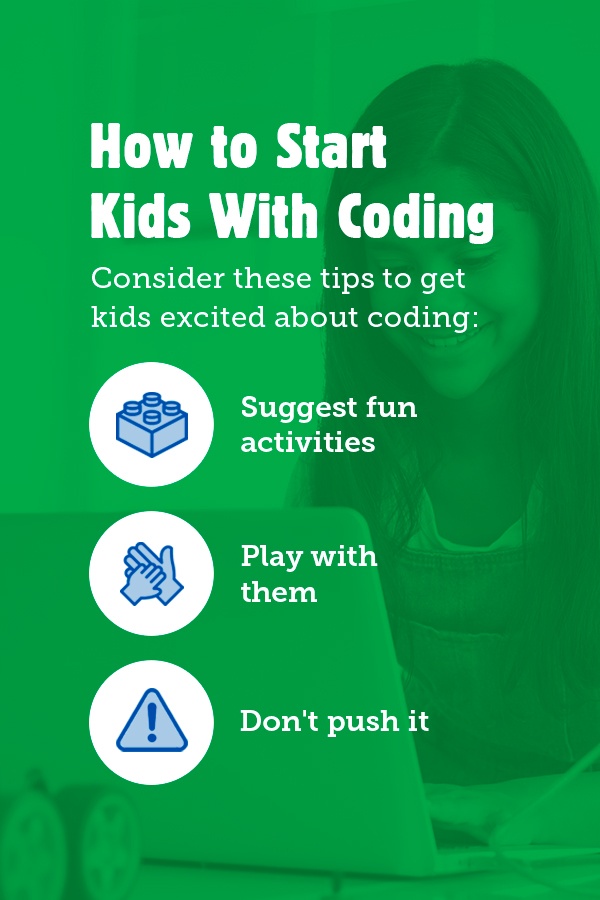
How to Start Kids With Coding
With so many beneficial skills to develop through coding, you’ll want to get your kids involved in programming today. Whether your child has expressed an interest in coding before or you’re curious to see if they’d enjoy it, consider these tips to get kids excited about coding:
- Suggest fun activities: There are fun ways to teach kids to code that don’t only involve typing code. Scratch, LEGO® WeDo and LEGO® Mindstorms engage kids to teach fundamentals of coding.
- Play with them: You don’t need to know how to code to enjoy these activities with your child. Help them explore coding and discover what they enjoy doing together. Engage with them, ask questions about what they’re doing and let them teach you. They’ll be excited to share their projects and knowledge with you, even if you don’t know how to code.
- Don’t push it: Some kids may not find coding as interesting as others, and that’s okay. There are plenty of puzzle-based activities and programs that develop similar skills. You can always try to gauge their interest in coding after a while or try different coding activities for kids to see what they enjoy.
Does your child have an interest in coding? While coding games and activities are a great place to start, there are tons of classes and programs. When you enroll your child in a coding class, activity or program, they’ll get the benefit of:
- Knowledgeable teachers: Coding programs often use knowledgeable teachers to lead the course or program. This takes the pressure off you to know how to teach your kids to code, either on fundamental or complex levels. Leaders and teachers will provide direction and can explain any concepts your child wants to learn more about or doesn’t understand.
- A group environment: With many programs, your kid will learn about coding while also developing communication and social skills. They’ll learn and interact with their peers and may get more excited about coding and creating.
- The right equipment: Some programming classes provide the tools kids need to practice coding. From the right software and apps to physical hardware like LEGO® Bricks and motorized components, you won’t have to worry about getting these yourself.
After seeing how coding helps kids develop important skills and how easy it can be to get started, it’s time to find a program that works for your child.
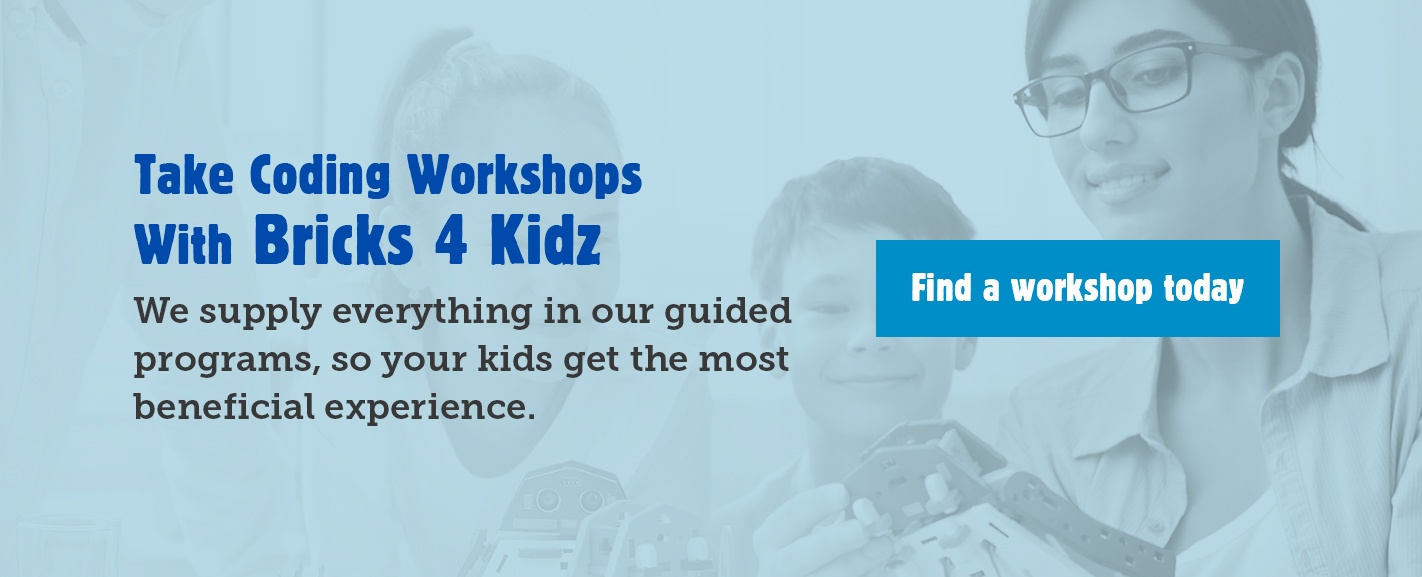
Take Coding Workshops With Bricks 4 Kidz
Give kids the freedom to explore coding and other STEM fields in their own creative ways with our help. Bricks 4 Kidz offers after school programs, camps, workshops and more for kids utilizing LEGO® Bricks and other software, which promote creativity and engagement. We supply everything in our guided programs, so your kids get the most beneficial experience. They’ll work together with other kids, all while exploring robotics, engineering, programming and more.
Find a workshop today, and discover how to get kids excited about coding. Try something new with your child, and you might just help them find their new hobby or dream career.